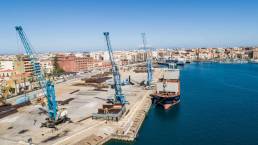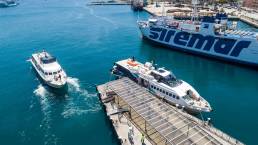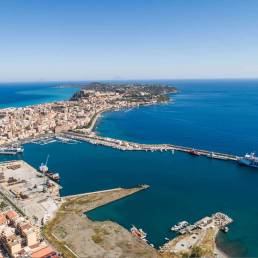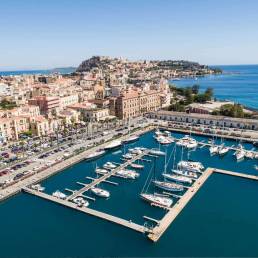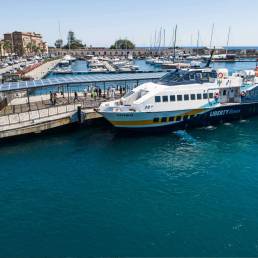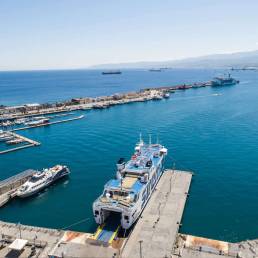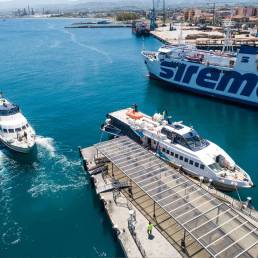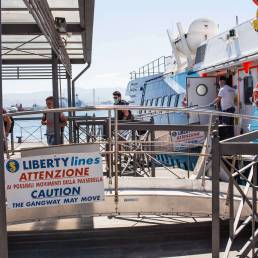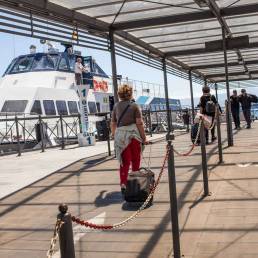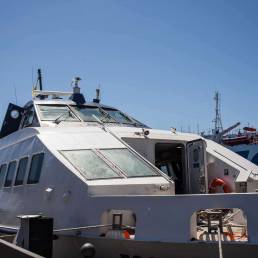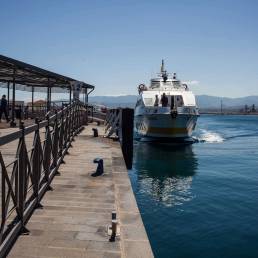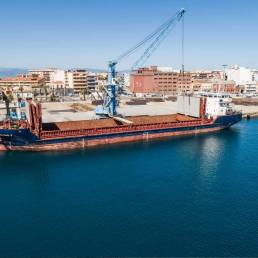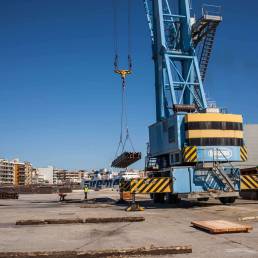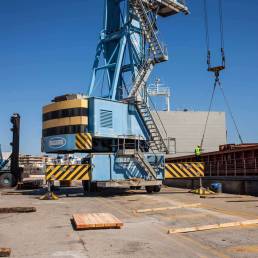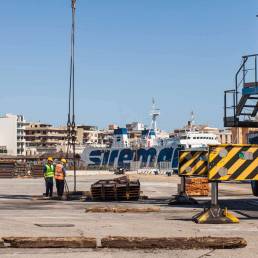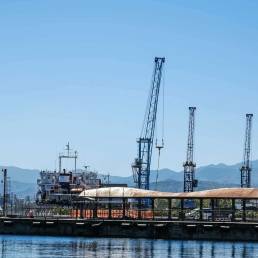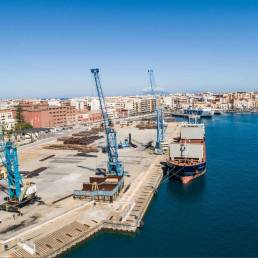Characteristics
The port of Milazzo is located at the root of the peninsula of the same name and has a total length of the quays of about 2,000 m with 12 berths and a depth of the seabed between about 6 and 11 m and contains a single basin In Milazzo port there are ship repair companies operating in the energy and steel industry of international importance.
The primary port functions currently develop in two main areas: in the historic port there is the connection of passengers and goods with the Aeolian Islands and Naples, the movement of goods and, in particular, of steel products. Just outside the port’s stretch of water, there is a crude oil refining terminal of primary importance with three docking piers for large tankers with a potential for docking equal to four contemporary units. Beside the same oil complex there is also a thermoelectric power station which is powered by the petroleum products refined there.
The entrance of the port is signaled by an intermittent green light on the head of the breakwater, on which there is a structure candelabrum shaped that supports a fixed red light.
All piers are well lit throughout their length.
History and Myth: Port of Milazzo
The first settlements in Milazzo date back to the Neolithic age (4,000 BC). The city acquired prosperity between the seventh and sixth centuries BC, when, with the expansionist hegemony of the Greek populations of Zancle, Milazzo was also transformed into a fortified “Polis”. The submission to Messina lasted until 270 BC, the year in which, following a bloody battle, Milazzo was occupied by the Syracusan Gerone II. In the Roman period its waters were the scene of two important naval battles: in 260 BC. the Roman fleet commanded by the consul Caio Duilio triumphed over the Carthaginian (First Punic War); in 36 BC, the city, which became the naval base of Sesto Pompeo, was linked to the events of the war between them and Octavian who, supported by Milazzo, was leaded to victory. Following the victory, the city was given civic recognition by Octavian with the eagle and the motto “Aquila mari imposita – Sexto Pompeo surpassed“. Under the Eastern Empire, the town was part of an important defensive triangle and became one of the main Sicilian bishops. The Muslim domination began with the conquest of Milazzo by Fadhl Giafar (843 AD), and became chief town of a thriving agricultural and commercial center in the territorial district called “Tallo di Milazzo”. The construction of the large tower of the “Maschio”, referred to as “Saracen” and the introduction of tuna fishing, dates back to this period.
In 1061 Ruggero d’Altavilla took possession of the city and the fort, making it the bridgehead for the Norman conquest and the expulsion of the Muslims from Sicily. It was then incorporated into the royal state property by Frederick II of Swabia and for three centuries it was affected by the wars between the Angevins and the Swabians; during the sixteenth century. it was the scene of troubled war events, linked to the feudal conflicts that bloodied Sicily. During the Spanish domination the city increased its strategic importance. The important and impressive fortifications of the historic castle date back to this period and can still be admired today. The last flashes of Spanish domination ended in 1713 when the sovereignty of Sicily passed to Vittorio Amedeo II of Savoy. Under the Bourbons the city maintained its strategic-military role.
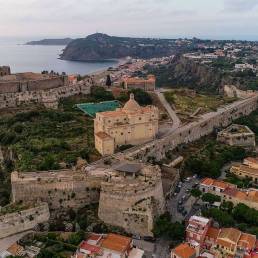
During the Napoleonic wars it became an English stronghold, hosting large fleets and garrisons. The 20th of July 1860 Milazzo was the scene of the famous battle between the Garibaldi’s troops and the fleets od Francesco II di Borbone. With the advent of the “Regno d’Italia” the city lost its importance. During the last World War, Milazzo suffered massive and bloody bombings. The city, together with Catania, Augusta and Palermo, was identified as a landing area in the English plan for the invasion of Sicily, called “Whipcord“, which was to take place on 9th December 1941, but was canceled on 30th October. During the “Husky” invasion planned in July 1943, the port of Milazzo was strengthened as an important maritime, railway and military center.
The History of Milazzo is lost in myth so much so that tradition recalls the Cave of Polyphemus located on the ridge of the Rocca, on which the Castle now stands. Legend tells that Polyphemus ruled the armaments of the Sun God, in this land (called Chersonese d’Oro) famous in Grece for its beauty, climate and fertility, when Ulysses landed there after a shipwreck.
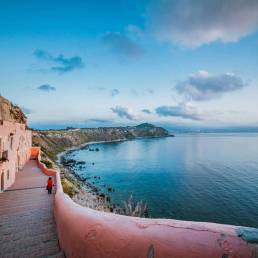
STATISTICS
Statistics of the Port of Milazzo
Statistics regarding the tons of goods, hydrocarbons and the number of passengers transiting the Port of Milazzo
GOODS
15,646,984t
Year 2021
PASSENGERS
846,241
Year 2021



